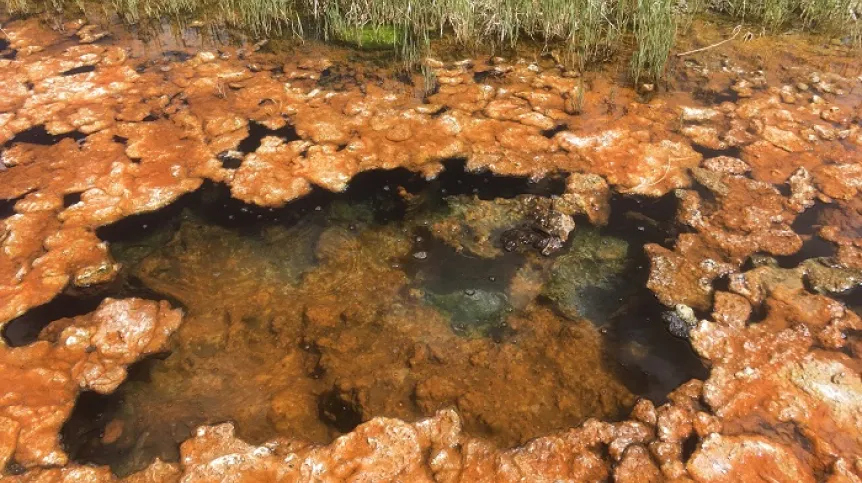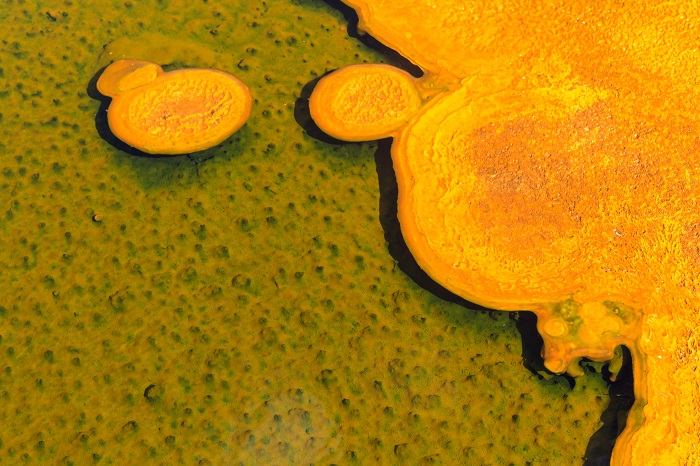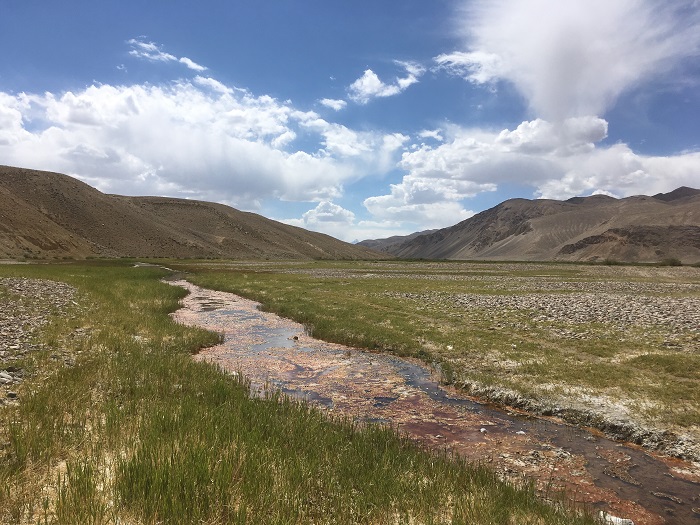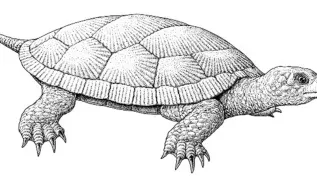
Scientists have discovered a completely new genus (a taxonomically higher unit) of cyanobacteria.
Led by Dr. Iwona Jasser from the University of Warsaw’s Faculty of Biology, the researchers found that the previously known species lives in a geothermal spring in the East Pamir Mountains (Tajikistan).
According to the scientists, it may turn out to be not only a new evolutionary line of cyanobacteria, but also a potential producer of valuable bioactive substances.
A paper describing the new organism, as well as others isolated from geothermal environments in Iceland, Poland, Greece and Tajikistan, appeared in the journal Molecular Phylogenetics and Evolution.
Dr. Jasser said: “We were all interested in studying hot springs because we thought they might contain new and interesting cyanobacteria.
“In my case, it started with the fact that while exploring the Eastern Pamir Mountains I accidentally stumbled upon an unusual geothermal spring: at a length of almost 200 m it was covered with a very thick layer of green-brown +sheepskin+.
“It looked amazing. We decided that it was definitely worth examining it more closely, because it was certainly something unusual.”
The three scientific teams, which included Professor Spyros Gkelis from the Aristotle University of Thessaloniki (Greece) and Professor Mikołaj Kokociński from the Adam Mickiewicz University in Poznań, brought a fragment of that 'sheepskin', which in fact was a microbial mat, to Poland.
They examined it under a microscope, performed biochemical and molecular analyses, and checked which organisms could be isolated from it. As they suspected, cyanobacteria were isolated from the mat and then grown in the laboratory.
Dr. Jasser said: “The cultivation of organisms from such specific, extreme environments is very difficult, because we are not able to provide them with conditions in which they live naturally, even if we ensure a sufficiently high temperature, etc. Any such isolation and culture that can be carried out is a big success. And this time we did succeed.”
Although morphologically single individuals did not appear particularly interesting or unique, molecular analyses (based on DNA) showed that the cyanobacteria brought from Tajikistan was very difficult to match to any of the existing taxonomic groups.
Jasser said: “In the past, the taxonomy of cyanobacteria used to be based solely on their morphological features, primarily the shapes and organization of cells.
“We divided them into filamentous cyanobacteria, coccal cyanobacteria, filamentous cyanobacteria with heterocytes (specialized cells for the assimilation of nitrogen from the air), branched filamentous cyanobacteria, and even those that form complex, three-dimensional structures made of many filaments.
“Later it turned out that in the process of evolution, over millions of years, cyanobacteria would alternately lose and regain their complex, multicellular structures. Therefore, the division based on morphological features turned out to be completely insufficient. Today we know that despite having the same appearance, cyanobacteria can belong to very different genera. Only DNA analyses reveal the true kinship between these organisms'.

This was the case with cyanobacteria discovered in the Pamir Mountains. Molecular analyses revealed that it could not be classified as any previously known species of cyanobacteria. Not only that, it turned out to be unlike any described genus!
The scientists quickly realized that they had discovered a new group of organisms. They named the unusual cyanobacteria Hillbrichtia pamiria. Pamiria refers to the place where it was found, Hillbrichtia to the name of the late Polish hydrobiologist, Professor Anna Hillbricht-Ilkowska.
Dr. Jasser said: “We named it after my mentor, Professor Anna Hillbricht-Ilkowska. She was a well-known ecologist and hydrobiologist not only in Poland but also in the world; a two term Vice President of Societas Internationalis Limnologiae, the world's major limnology organization. She was also the supervisor of my doctoral dissertation and a great authority. I wanted to commemorate her as an amazing scientist and a wonderful person.
“So far, we have modestly stated that Hillbrichtia is a new genus. However, even on a higher level it is difficult to find the right group for it. It is therefore possible that it may even be a new order. To confirm, we will need to find organisms similar to it. Then all will be clear.”
In addition to H. pamiria, two other completely new cyanobacteria species and one more new genus were described in the publication. The latter was discovered in Greece by Professor Spyros Gkelis' team.
She said: “As for Hillbichtia, it was clear at first glance that it was a unique organism. It built microbial mats that we had not seen before, it could grow at very high temperatures, but - interestingly - also at much lower ones. At the source of the thermal stream we examined, the temperature reached 50 degrees Celsius, but 200 meters away it was only 28 degrees C. And the cyanobacteria was doing very well in both places. This means that it has great adaptive capabilities.”
She added that microbial mats are multilayer sheets of many biofilms. These biofilms are formed mainly by cyanobacteria, although subsequent layers can be dominated by various other microorganisms.
Dr. Jasser continued: “The basis of the mat are cyanobacteria, because, first of all, they are the primary producers, they photosynthesise, provide organic carbon, as producers they form the basis of the trophic network, and secondly, they can create very large colonies with a specific structure and a large amount of extracellular mucus (exopolycarbonates) , which are a place to live for further organisms.
“Next to cyanobacteria, other photosynthesising organisms begin to develop: eukaryotic algae, such as chlorophytes or diatoms, and later also heterotrophic organisms: archaea, anaerobic bacteria.
“Autotrophic bacteria can also develop, but these would be anaerobic ones that do not produce oxygen. As a result, there are many different layers in the mat, and the organisms forming them have very different roles.”
Microbial mats formed, among other things, by cyanobacteria releasing oxygen in the process of photosynthesis, were among the first clusters of organisms that lived on Earth. Traces of them can still be seen today. They already existed about 3-3.5 billion years ago and for a long time they remained the only and most important ecosystems on our planet. The Earth's atmosphere was initially created thanks to cyanobacteria. Through endosymbiosis, cyanobacteria also became permanent components of other eukaryotic photosynthesising organisms.
The authors of the publication also compared cyanobacteria isolated from mats brought from several different hot springs: Dr. Jasser's mat from Tajikistan, mats brought Professor Mikołaj Kokociński's team from the area of Uniejów and two mats from by Professor Spyros Gkelis' team in Greece and Iceland.

Dr. Jasser said: “We began to compare the ecophysiological properties of cyanobacteria we had isolated; we checked their phylogenetic affiliation. We also wanted to investigate whether and which genes coding heat shock proteins and enzymes of polyketide synthesis (PKS) and nonribosomal peptide-synthetase (NRPS) enzymes were present in our cyanobacteria.”
She added that heat shock proteins (HSPs) as well as PKS and NRPS enzymes are specific compounds the expression of which increases in stress conditions, such as very low or very high temperatures, strong salinity, heavy metal presence. The fact that the studied cyanobacteria originated from hot springs allowed scientists to assume that they should have such proteins.
These assumptions were quickly confirmed. In addition, the researchers established that those cyanobacteria that had three HSP-coding genes - and those, in which PKS and NRPS genes were present - did best at high temperatures. Interestingly, the genes coding PKS and NRPS belong to the group of genes also associated with the production of toxins.
Jasser said: “This is consistent with the hypothesis that the genes associated with toxin biosynthesis pathways allow microorganisms to adapt to difficult environments.”
During the experiments, it turned out that Hillbrichtia pamiria produced another, extremely interesting substance. It is debromoaplysiatoxin- a substance knows to cause allergic reactions, including strong itching, and effects similar to burns. In addition, research on mice revealed that it promoted the formation of cancerous tumours and other disorders, including those leading to death.
At the same time, the same compound, if certain components are removed from it in a laboratory, has a completely opposite effect: it can inhibit the development of cancer cells.
Dr. Jasser said: “This is an extremely interesting compound, and we have confirmed that this specific cyanobacteria produces it.
“Interestingly, it could not be found in natural conditions, in the mat brought from Pamir, only in a laboratory culture.
'We should certainly subject Hillbrichtia pamiria to even more detailed biochemical and genetic analyses to see if it produces any other interesting biologically active compounds.”
PAP - Science in Poland, Katarzyna Czechowicz
kap/ zan/ kap/
tr. RL













